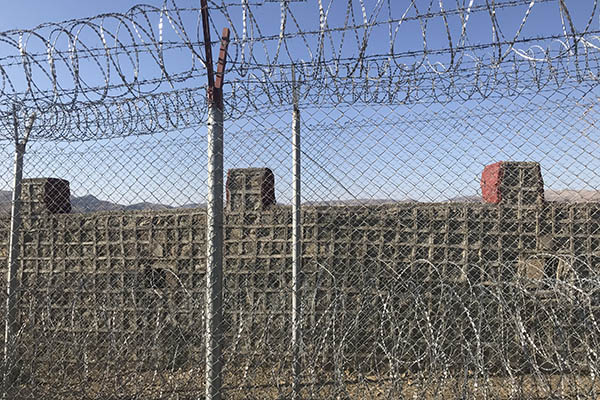
The under-construction 2,600km border fence between Pakistan and Afghanistan. Photograph by Nazar Ul Islam
Growing importance for Pakistan’s Western border as a U.S. withdrawal from Afghanistan looms
Pakistan Army chief Gen. Qamar Javed Bajwa has concentrated his attention on the country’s western border, while encouraging Prime Minister Imran Khan to reach out to India with “trade” and push ahead with the now-popular Kartarpur Corridor.
Since assuming his post as Chief of the Army Staff, Bajwa has pushed to fence Pakistan’s border with Afghanistan and Iran, even as our troops have faced a violent response from across the border, with soldiers involved in the fencing of the unacknowledged-by-Afghanistan Durand Line targeted with gunfire and shelling. The Army chief has clearly signaled that Pakistan feels vulnerable on its western border. It likely helps that Pakistan has woken up to the simple fact that smuggling at the Torkham border has been undermining the country’s economy.
Now that the U.S. has decided to quit Afghanistan, one must take a look at the new directions of threat Pakistan will face in consequence of the withdrawal. Pakistan voiced its displeasure at U.S. drone strikes on its soil, but certainly benefited from attacks that killed some of its most lethal homegrown enemies, such as Nek Muhammad, Baitullah Mehsud, Hakeemullah Mehsud, Mangal Bagh. These gains helped the Pakistan Army directly target the Pakistani Taliban and force them to flee into Afghanistan.
It is normally believed that the Pashtun in Afghanistan are friendly toward Pakistan because of their race and religion; 40 percent of Afghanistan’s population is believed to be Pashtun, or 14.7 million, which is far less than the 32.8 million residing in Pakistan. The Pashtun of Afghanistan inhabit mostly southern Afghanistan, while the north is dominated by non-Pashtuns such as the Persian-speaking Tajiks. The north is hostile to Pakistan while the south is where Pakistan wields influence. In Kabul the “coerced” coalition of Pashtuns and non-Pashtuns is supposed to look to Pakistan for support; it seldom does.
With the defeat of the “friendly to Pakistan” Taliban government in 2001 at the hands of an international coalition of forces under a Chapter Seven U.N. Resolution, Pakistan got its 5 million, mostly Pashtun, refugees but lost all support in Kabul. Afghanistan’s neighbors are scared of Pakistan after it became a spawning bed of terrorism for their rebels. Iran, supporting the Tajik-dominated coalition of the north and fearing the rabidly anti-Shia Taliban, became sensitive to its eastern border long ago, especially after 19 of its officers were killed at its Mazar-e-Sharif consulate in 1998 by Taliban who were “greatly helped by thousands of Pakistan’s Sipah-e-Sahaba, pro-Al Qaeda, sectarian warriors.” After Pakistan’s Operation Zarb-e-Azb in 2014 killed more than 3,500 militants in North Waziristan, Pakistan faces a monolith of opposition forces on its western border.
If Pakistan indulged in “asymmetric war” against India in the past decades using non-state actors, including warriors from its tribal areas, it is no longer able to do so today because of the stab-in-the-back phenomenon of its Pashtun and non-Pashtun enemies in Afghanistan. It can’t reconcile with the Tajiks of the north and it has made enemies of the Taliban to save itself from becoming a jihadi wilderness. It has also to reconcile the Pakistani tribal Pashtuns who were brutalized by the “guest” Taliban and their hosts whom Pakistan had trusted.
Today, India has arrived at the Kautilyan conclusion that it has to increase its presence in Afghanistan and assist against Pakistan the forces that Pakistani policies had ended up creating. Classical Indian thinker Kautiliya recommended keeping the immediate neighbors under pressure while linking up with “states beyond.” That is what India has done over the years when Pakistan was busy handling the fallout from its Afghanistan policy of “strategic depth.” It has funded hostile-to-Pakistan governments after the ouster of Taliban from Kabul. It has, with Iranian help, diverted the Pakistani “Afghan trade” route to the port of Chabahar in Iran linked to Afghanistan by a highway, thus bringing Pakistani leverage to naught.
In his book My Enemy’s Enemy (2019) Avinash Paliwal writes: “Despite the Ministry of External Affairs’ official line of a stable Afghanistan and non-interference from external players, there was a silent undercurrent in India’s security establishment that viewed Afghanistan as Pakistan’s Vietnam and preferred Pakistan Army to get bogged down.” Paliwal also quotes an Indian national security adviser as saying: “Ultimately the game is how you make Afghanistan strong enough to fight Pakistan or to bleed Pakistan inside Afghanistan.”
Given the post-U.S. withdrawal prospect, it is right for Pakistan to think of the western border as more integral to its security. The corollary of this thinking is “normalization” with India spearheaded by trade. Over the years, it has developed many internal vulnerabilities. The Durand Line abuts on territories where the writ of the Pakistani state is weak, where populations are disaffected by past policies and need to be engaged in dialogue. Pakistan’s economy is in dire straits because of its past misadventures—call them “geopolitical compulsions”—and there is political instability to obstruct any national consensus on how to proceed after the U.S. withdrawal; not to mention the potential resulting civil war in Afghanistan, which will push more refugees into Pakistan regardless of however many fences we put up.
